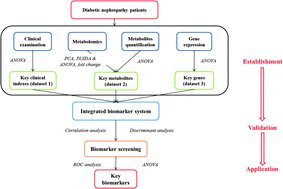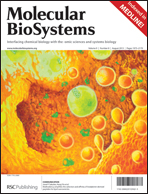Diabetic nephropathy is a devastating disease that affects a growing number of diabetic patients. A complete cure is very hard to achieve once the disease has been diagnosed, therefore the diagnosis of early stages in diabetic nephropathy has become a hot area. Numbers of molecules have been proposed to be potential biomarkers for this purpose. However, some problems still remain, such as discovering effective biomarkers to diagnose the disease before obvious clinical evidence appears. Thus, the main purpose of this study was to find plasma biomarkers for early diagnosis of type 2 diabetic nephropathy stage 1 and stage 2, as well as separating them from diabetes. 182 subjects (Chinese) were recruited for this study, including 50 healthy controls, 33 type 2 diabetic patients and 99 type 2 diabetic nephropathy patients (33 of these were stage 3). Important clinical indicators including proteinuria, serum creatinine, and urea nitrogen were measured and the glomerular filtration rate was estimated to assess kidney function; fasting blood glucose, postprandial blood glucose and glycated hemoglobin were measured to assess the blood glucose control. Key metabolites and genes in plasma samples were identified and determined using -omic and quantitative techniques. The potential biomarkers were then combined and carefully screened to determine the most informative ones for early diagnosis of type 2 diabetic nephropathy. An integrated biomarker system (IBS) incorporating 6 clinical indicators, 40 metabolites and 5 genes was established. Correlation analysis results revealed that most of the potential biomarkers significantly correlated with the 6 clinical indicators. Discriminant analysis results showed that the developed IBS gave the highest total predictive accuracy (98.9%). Significant test and receiver operating characteristic analysis results indicated that inosine had the highest sensitivity (0.889), specificity (1.000), positive predictive rate (1.000) and negative predictive rate (0.900) amongst the 48 potential biomarkers when separating patients with diabetes from patients with diabetic nephropathy stage 3. Finally, inosine with a cutoff of 0.086 mg L−1 was combined with estimated GFR to differentiate between diabetic nephropathy stages 1 and 2 from diabetes. The results demonstrate that IBS combined with a proper statistical analysis technique is a powerful tool for biomarker screening.

You have access to this article
 Please wait while we load your content...
Something went wrong. Try again?
Please wait while we load your content...
Something went wrong. Try again?


 Please wait while we load your content...
Please wait while we load your content...